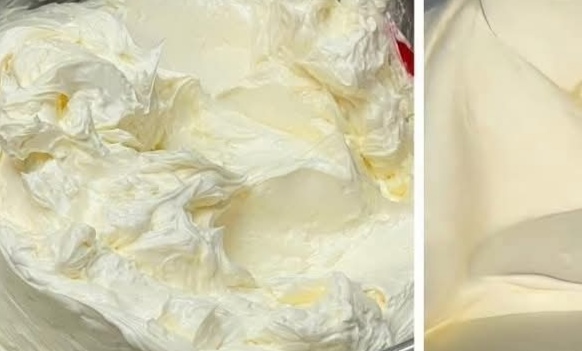Ingredients:
- 1 1/2 cups unsalted butter, room temperature
- 4 to 5 cups powdered sugar, sifted (adjust to taste)
- 1/4 tsp fine salt (adjust to taste)
- 4 tsp vanilla extract
- 3-4 Tbsp heavy cream or whole milk (adjust for consistency)
Instructions:
- Beat the Butter: In a large bowl, beat the butter with a mixer on medium-high speed until light and fluffy (about 2-3 minutes).
- Add Powdered Sugar: Gradually add the powdered sugar, one cup at a time, beating well after each addition.
- Add Flavoring: Mix in the salt, vanilla extract, and 3 tablespoons of heavy cream or milk.
- Adjust Consistency: Beat on high speed until smooth and fluffy. If the frosting is too thick, add more cream or milk (one teaspoon at a time) until the desired consistency is reached.
Construction (How to Use It)
- Filling: Spread a thick layer between cake layers.
- Crumb Coat: Apply a thin layer to seal in crumbs before the final coat.
- Final Layer: Smooth or pipe the frosting over cakes, cupcakes, or cookies.
- Decorating: Use piping bags and tips for intricate designs.
Variations
- Chocolate Buttercream: Add 1/2 cup unsweetened cocoa powder or melted chocolate.
- Strawberry Buttercream: Add 1/4 cup strawberry puree and reduce liquid slightly.
- Almond Buttercream: Replace vanilla extract with almond extract.
- Coffee Buttercream: Dissolve 1-2 tsp instant coffee in the milk/cream before adding.
- Maple Buttercream: Swap vanilla extract for maple syrup.
Tips for Perfect Buttercream
- Use Room Temperature Butter: This ensures a smooth, creamy texture.
- Sift the Sugar: Prevents lumps and makes the frosting lighter.
- Beat Thoroughly: A well-beaten buttercream is fluffy and easy to spread.
- Chill for Piping: If the frosting becomes too soft, refrigerate for 10-15 minutes before using.
- Storage: Store in an airtight container in the fridge for up to a week or freeze for up to 3 months. Re-whip before use.
Would you like any adjustments to the recipe or more specific piping techniques?

